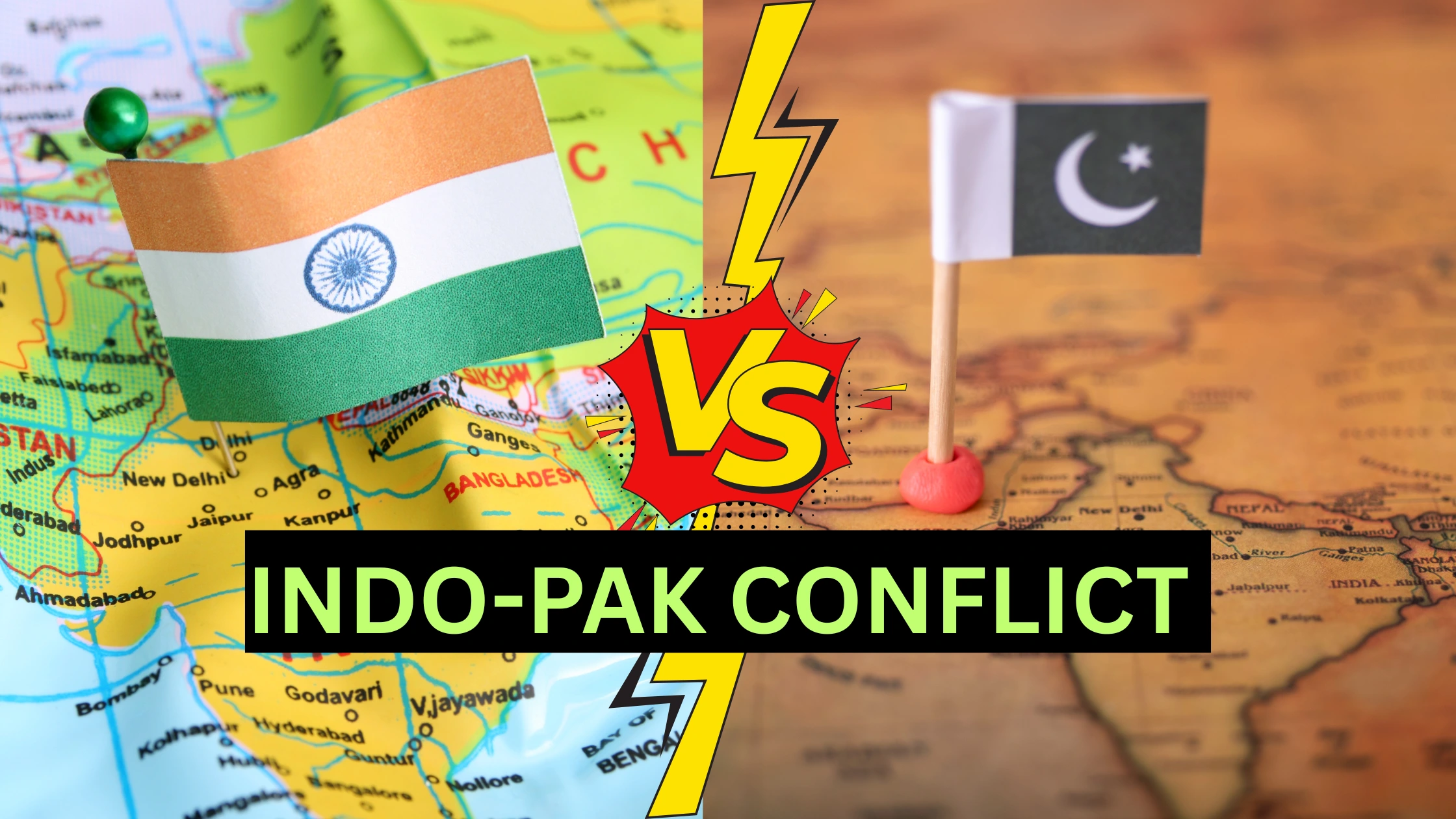Introduction: India-Pakistan conflict
In 2025, South Asia finds itself on the brink of a possible military confrontation as tensions between India-Pakistan resurface in an increasingly volatile geopolitical environment. What began as a series of border violations and sharp rhetoric has now escalated into heightened military alerts, international diplomatic intervention, and growing public anxiety.
This blog explores the root causes, recent developments, global reactions, and potential consequences of the 2025 India-Pakistan conflict.

Background: A History of Fragile Peace
India-Pakistan have shared a historically tense relationship since their partition in 1947. The two nuclear-armed nations have fought multiple wars—in 1947, 1965, 1971, and the Kargil conflict in 1999. While peace talks and backchannel diplomacy have occurred in recent years, the Line of Control (LoC) in Jammu & Kashmir remains one of the most volatile borders in the world.
Despite intermittent ceasefires, skirmishes, infiltration attempts, and proxy conflicts have kept the region under constant tension.
What Sparked the 2025 Crisis?
The current episode of hostility began in late April 2025 when an Indian Army patrol unit was ambushed in the Poonch sector of Jammu and Kashmir. The attack, reportedly executed by armed militants with alleged links to Pakistan-based terror outfits, resulted in the death of seven Indian soldiers and injured several others.
In retaliation, India conducted precision strikes on suspected militant hideouts near the LoC. Pakistan, in response, accused India of unprovoked aggression and threatened retaliation. This series of events has reignited fears of a full-scale conflict between the two nations.
Key Events in the 2025 Conflict So Far
1. Cross-Border Shelling Intensifies
Since early May 2025, heavy shelling and gunfire have been reported along several sectors of the LoC. Civilian casualties have mounted on both sides, with thousands fleeing border villages.
2. Mobilization of Troops
Both countries have ramped up military deployments. India has moved additional brigades to the northern frontier, while Pakistan has placed its Air Force on high alert.
3. Airspace Restrictions
Pakistan temporarily closed its airspace over parts of Punjab and Khyber Pakhtunkhwa, while India issued NOTAMs (Notice to Air Missions) indicating restricted areas over Jammu and Kashmir for military operations.
4. Cyber Warfare & Propaganda
Social media platforms have seen a surge in propaganda, disinformation, and cyberattacks. Reports suggest that state-sponsored hackers from both sides have attempted to breach sensitive defense systems and civilian infrastructure.
International Reaction: Calls for Restraint
Global powers including the United States, China, Russia, and the European Union have urged both nations to exercise restraint and return to dialogue. The United Nations Secretary-General António Guterres issued a statement urging “both nuclear-armed neighbors to avoid actions that could destabilize regional peace.”
Meanwhile, the Organisation of Islamic Cooperation (OIC) has voiced support for Pakistan’s stance, while India has continued to emphasize its right to self-defense.
Impact on Civilians
The civilian toll of the conflict is rising. Over 60,000 villagers have reportedly been displaced from border regions on both sides. Schools are shut, businesses have halted, and hospitals are overwhelmed with casualties. The psychological toll—especially among children—has also drawn concern from human rights organizations.
Economic Fallout: Markets on Edge
The heightened conflict has rattled investor confidence. Indian and Pakistani stock markets saw significant volatility, with defense-related stocks soaring while travel, hospitality, and banking sectors dipped. Currency fluctuations and spikes in gold prices indicate growing uncertainty.
Defense Strategy: What Each Country Is Preparing For
India
India’s strategic response has included air surveillance operations, artillery deployment, and maritime mobilization. The Indian Air Force conducted simulated dogfights over Ladakh, while naval ships moved closer to the western seaboard.
Pakistan
Pakistan’s military response has included air drills in Sindh and troop deployment near the Sialkot border. Islamabad has also reached out to China for diplomatic support, given its alliance under the China-Pakistan Economic Corridor (CPEC).
Nuclear Concerns: A Dangerous Line
The possibility of nuclear confrontation, while unlikely, cannot be ruled out in a prolonged standoff. Both nations possess second-strike capabilities and nuclear arsenals that make escalation particularly dangerous. Defense analysts emphasize that any miscalculation could lead to a catastrophic outcome not just for South Asia but globally.
Diplomatic Channels: Any Hope for De-escalation?
Backchannel talks are reportedly underway through intermediaries in the UAE and Qatar. The Indian Ministry of External Affairs (MEA) has stated that “dialogue is possible but only after cross-border terror ceases.” Meanwhile, Pakistan’s foreign office has accused India of sabotaging regional peace for domestic political gains ahead of upcoming state elections.
China has offered to mediate, but India has traditionally opposed third-party involvement in bilateral issues. The U.S. has sent a special envoy to both capitals to try and broker a ceasefire agreement.
Voices From the Ground
“We heard loud booms around 3 AM. We ran with our children. We don’t know when we can go back,” says Parveen Bano, a resident of Uri sector who fled to a relief camp.
“My brother was on duty near Rajouri. We haven’t heard from him in two days,” said Amit Sharma, whose family is desperately seeking updates through Army helplines.
These stories highlight the human cost behind the headlines.
What’s Next: War or Peace?
As the standoff continues, the world watches closely. Analysts suggest three possible scenarios:
-
Full-scale war – A catastrophic outcome involving air, land, and possibly naval battles.
-
Limited conflict – Precision strikes, air raids, and covert operations.
-
De-escalation through diplomacy – Ideally, global mediation and internal restraint prevent further conflict.
Both nations have much to lose in a war—economically, diplomatically, and in terms of human life.
Conclusion: A Call for Responsibility
The India-Pakistan war news of 2025 is not just about military action or politics—it’s about the future of over 1.5 billion people in South Asia. The international community, regional leaders, and citizens alike must pressure both governments to prioritize dialogue over destruction.
While national security is paramount, it must not come at the cost of peace, stability, and innocent lives.
For more news click here
For health related blog visit Medicovada.in
